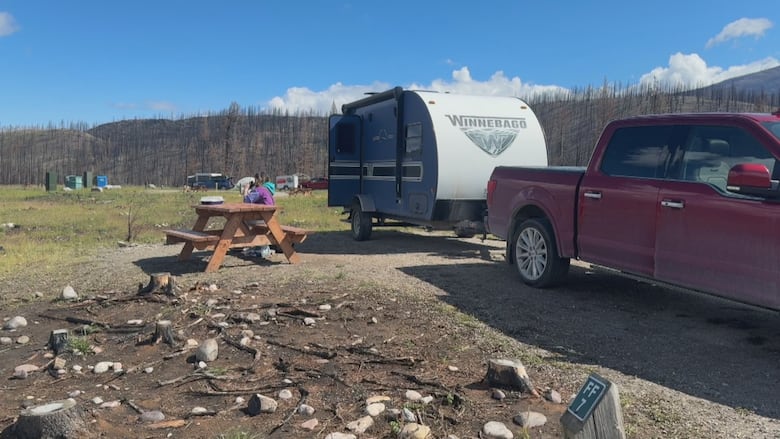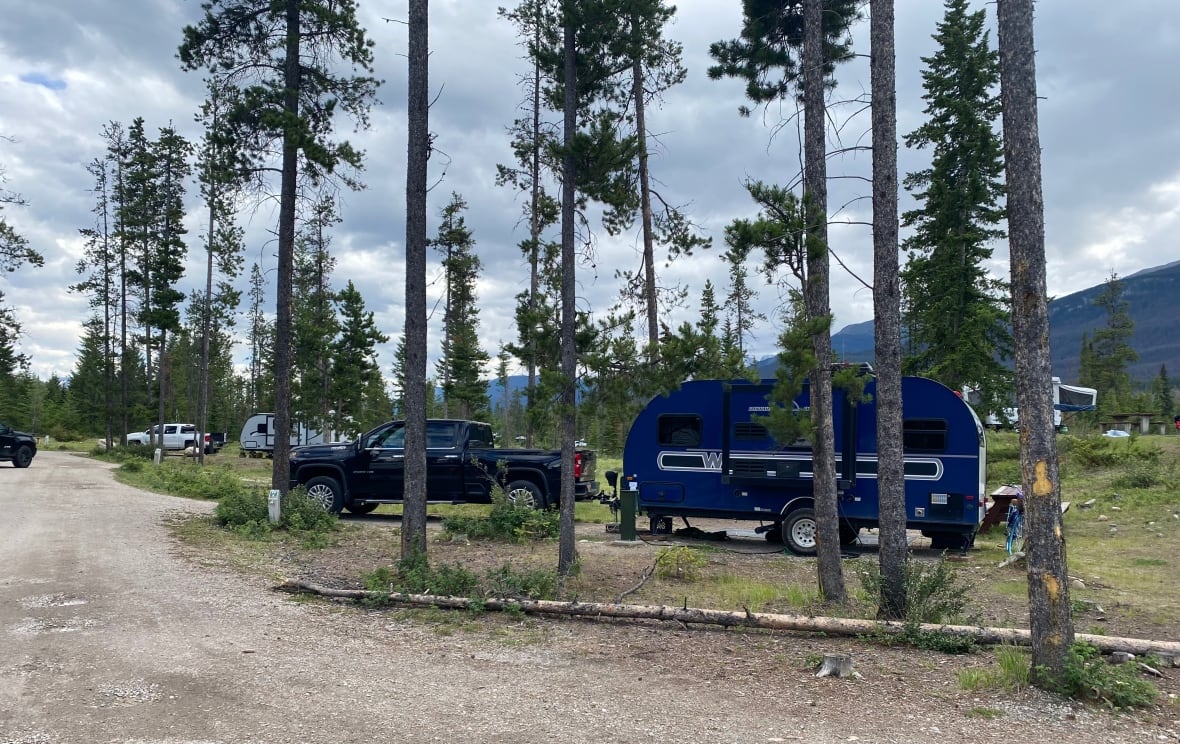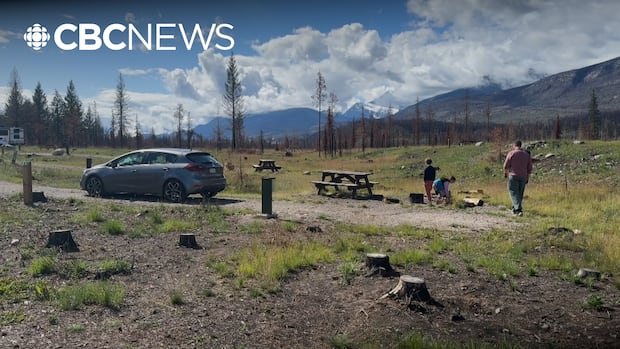Jasper campers take in radically new landscape, one year after wildfire
At the nearly treeless Wapiti Campground, 30% of sites open to campers this season

Camping in Jasper National Park may be a surreal experience for returning visitors and a startling one for first-time tourists, nearly one year after wildfire ripped through sections of the park.
Two of Jasper's biggest and most popular campgrounds — Wapiti and Whistlers — have few trees.
"The landscape will look quite different," said Graham Wylde, Jasper's visitor experience manager with Parks Canada. "It is radically changed in terms of the viewscapes."
On the mountain slopes flanking Highway 93 peering over the Wapiti and Whistlers campgrounds, trees stand stiff like charred match sticks.
"Everyone will come to it in a different way in terms of their previous connection to it or their perception of what a fire impacted area is," Wylde remarked.
Parks Canada crews have been working since last fall to get the park ready for visitors by clearing debris from trails, roads, grounds and facilities; taking down hazard trees, reconnecting utilities, reinstalling signs.
- A first look at damage caused by massive wildfire that ripped through Jasper
- Jasper wildfire damage now estimated at $1.23B — and could go higher, insurance industry says
Many of the washrooms were undamaged and didn't have to be replaced, but Parks Canada rebuilt more than 1,000 picnic tables this past winter.
"There's a whole gamut of work that needs to be done," Wylde said in an interview with CBC News last week.
With the little tree cover now, people should plan to bring wind shelters or sun shelters, Wylde said, with the heightened exposure to the elements.
WATCH | Campgrounds in Jasper National Park look different this year:
About 30 per cent of the Wapiti Campground, or 120 of the 400 sites, are open for campers this season.
Down the road at Whistlers, about 97 per cent of sites are open.
Nearly 25,000 people were evacuated from the town and the park on July 22, 2024, as the wildfire that was started by lightning quickly turned into a monster fire and destroyed a third of the town's structures.
Regular and first-time visitors
Of the available sites to rent at Wapiti the week of July 7-13, 97 per cent were occupied, while 99 per cent were booked at Whistlers, Wylde said.
The campgrounds had their regular visitors, like Yudit Normandeau from Edmonton, who makes the trip every year with her extended family to their favourite site in Wapiti.
"There's no privacy, that's true," Normandeau said of the new landscape. "But if you walk around, everybody says hello to you, good night or good morning."
Aside from the family tradition of visiting Jasper and Wapiti, the family is showing its support by going into town to shop and dine, she said.
"We're here — there's no trees, there's nothing but we are here."
- Blaze that damaged Jasper, Alta., townsite was too powerful to stop, fire experts say
- How did the Jasper wildfire get so out of control?
Myra Dawnay, 17, remembers the campgrounds before the fire.
"It's definitely more windy because there's no trees and we couldn't put up hammocks," she said. "It was kind of disappointing not to see squirrels or bears, or animals besides crows."
Ash Odsen, 9, is part of Normandeau's extended family and recalls Wapiti two years ago.
"I was kind of sad for the trees because they all got burnt," Odsen told CBC News at the campground. "It was still really fun because I got to see the river, and I got to walk to the park and it was amazing."
Heather Kindopp arrived with her family from California Tuesday night after a stop at Banff National Park.
"That was shocking last night that there's no trees left," Kindopp said. "There's nothing to separate you from your neighbours, it's pretty open."
It also struck her because of the family's experience in California, where the Camp Fire of 2018 devastated the community of Paradise.
"That's the same with our fires — you see the news and you can't understand what it's like until you're in it [and] you see what has happened and what's been destroyed."
Tourism is necessary to rebuild the community, she added, and that the family would be going hiking and to see the glaciers in the park.

Parks Canada is planning to rebuild Wapiti within three to five years to restore it to 100 per cent capacity, and will close the campgrounds completely to do so.
Hundreds of trees had already been cleared from Wapiti in 2021 because of mountain pine beetle damage.
Farther south on the Icefields Parkway, several smaller campgrounds with 20 to 50 sites are still surrounded by trees, including Honeymoon, Jonas, Kerkeslin and Wilcox campgrounds.
Miette Campground east of the townsite is also open and fully-forested, Wylde noted.
Wabasso Campground and Whirlpool Group Campground remain closed.
A renewed landscape
Wylde said the new landscape is an opportunity to get a closer look at what lies beneath.
"Previously, what was hidden by the trees is now laid bare and the incredible mountain views are right out your tent or your RV door," Wylde said.
On the slopes of the mountains are valleys, ridges, waterfalls and streams.
"It's quite a stark difference but there's a renewed beauty to this area now post-fire."
Normandeau is also looking at the landscape as a reflection of life.
"Sometimes we go through times where everything is green and then everything is brown and burned and devastated but only from there we can actually rise up again," Normandeau said.
"Jasper is gonna be probably the nicest and even better place that we used to be."



